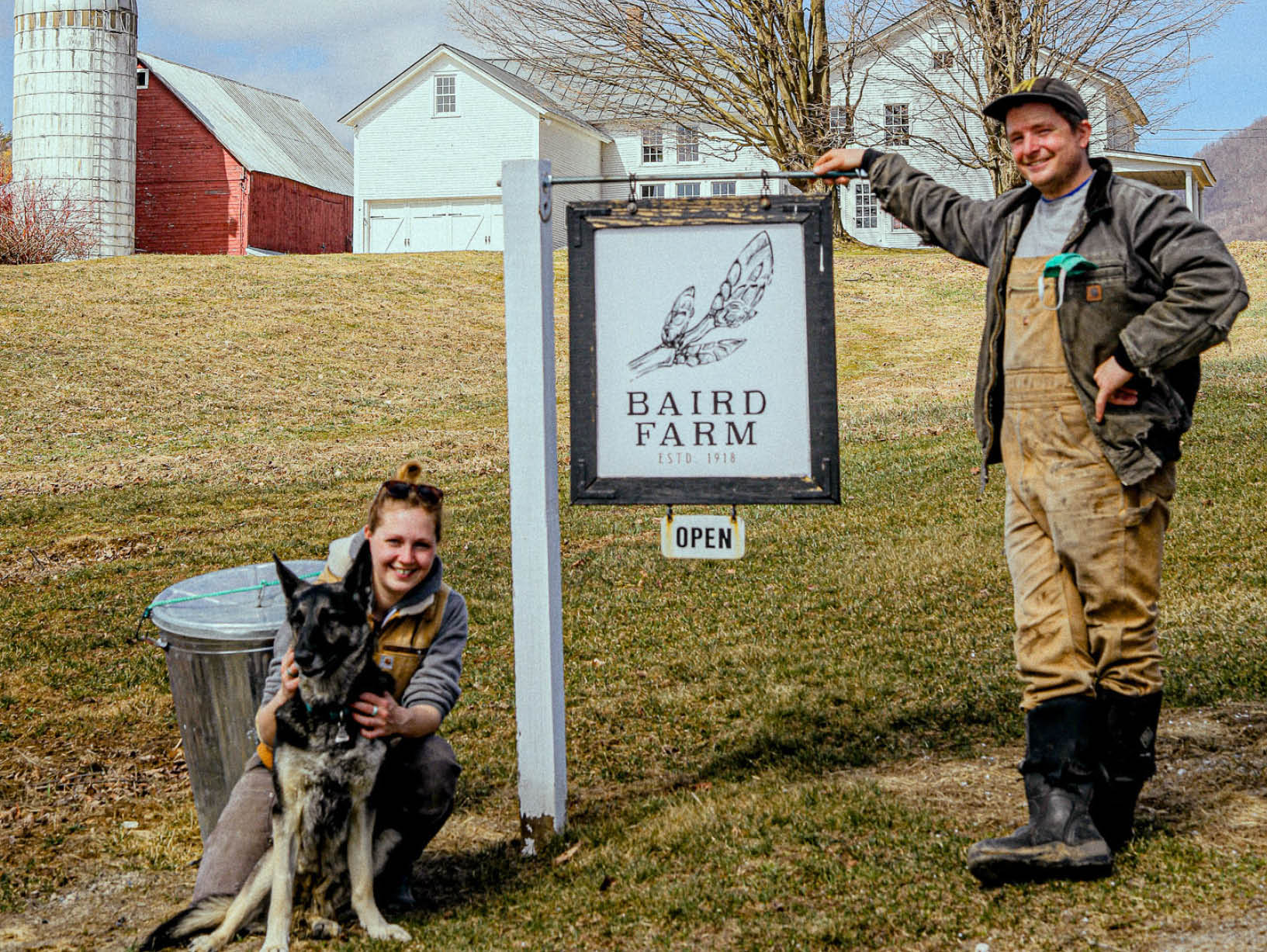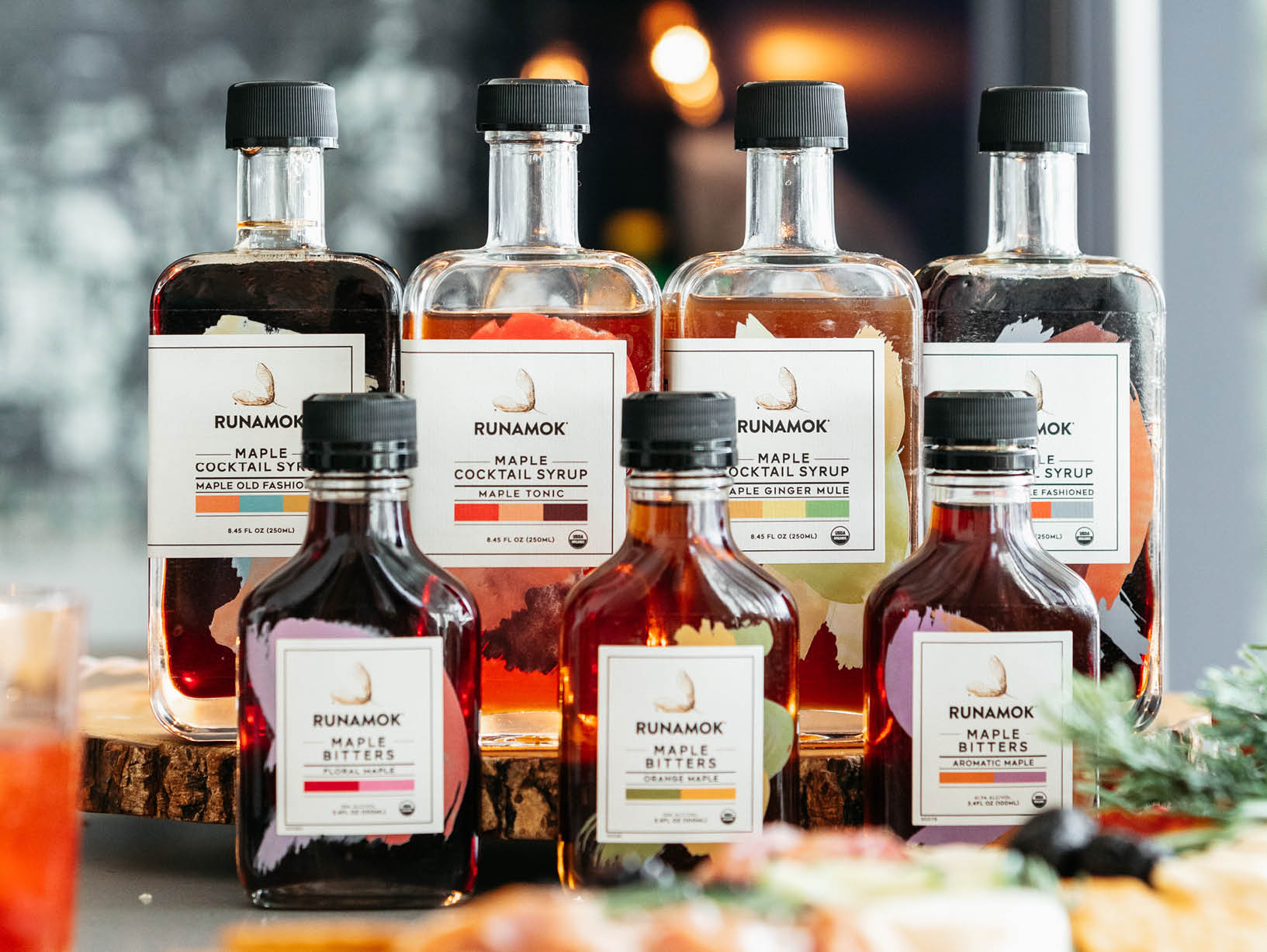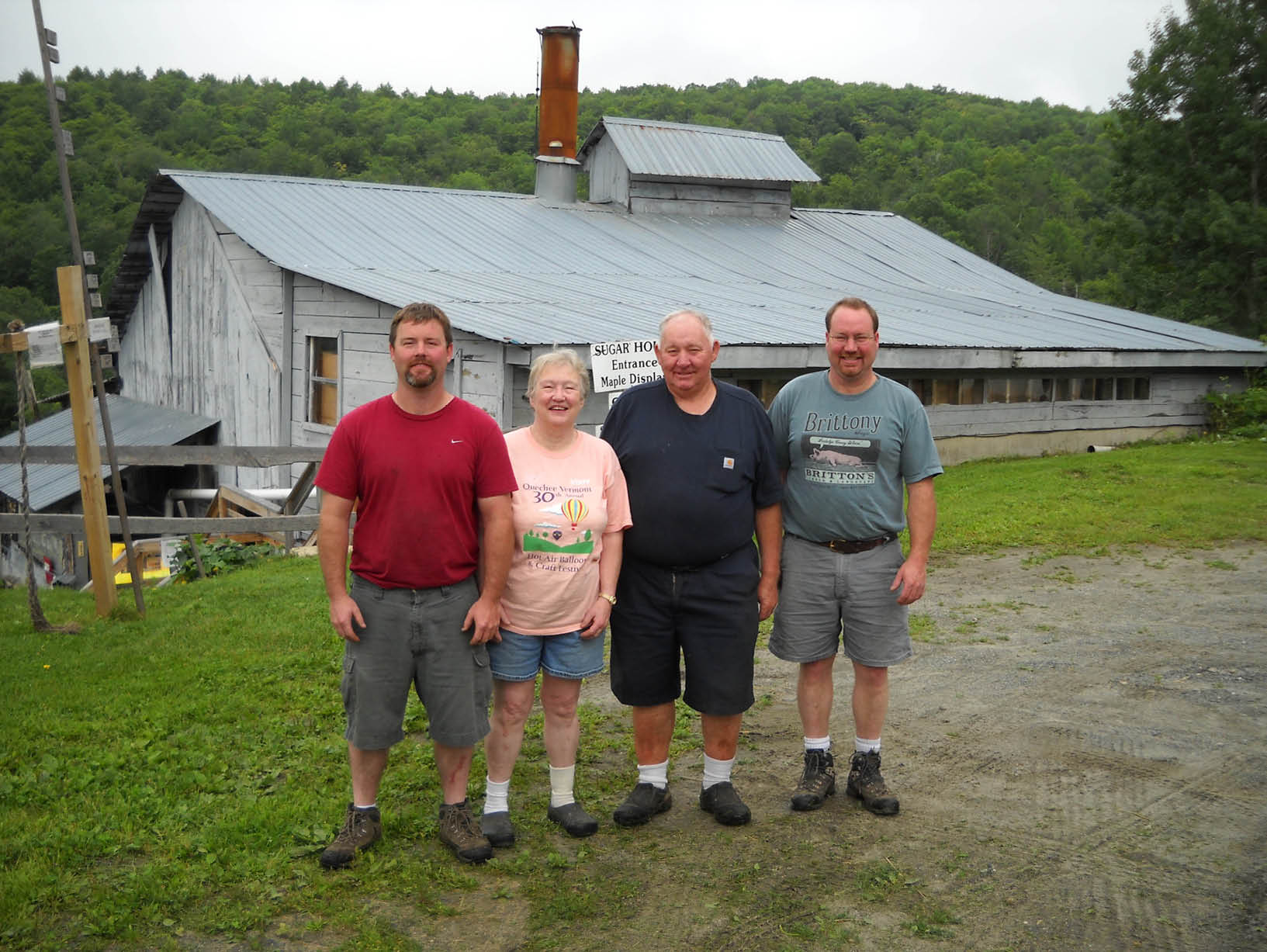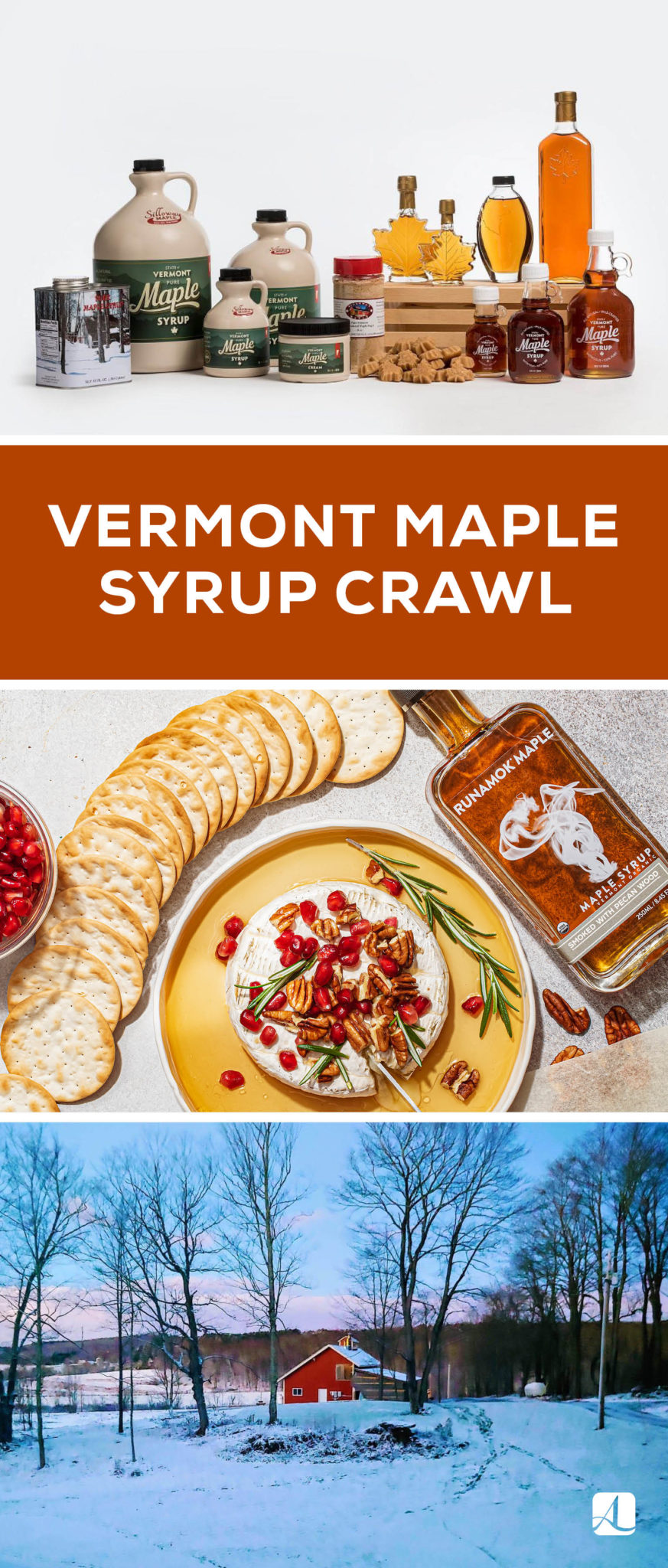Vermont Maple Syrup Crawl
© Runamok Maple | Photography as noted.
I spent my childhood pouring Log Cabin syrup over my Bisquick pancakes and waffles, oblivious to the fact that it contained no maple syrup at all. It was cheap, and my parents were not exactly foodies. Imagine my surprise when I went to purchase a bottle of real maple syrup for the first time—pricey! But as Laura Sorkin, the owner and founder of Runamok Maple, counters, “When you understand how much work goes into producing maple syrup, the price tag on the bottle makes more sense.”
In simplest terms, maple syrup is made by harvesting the sap of a sugar maple tree and concentrating the sugar content until it becomes maple syrup. As Sorkin explains, this is a very labor-intensive task: “The woods crew are often walking through three feet of snow with twenty pounds of gear on them. Given we have 70,000 trees to tap, it can take twelve people four to six weeks to get the job done.” Betsy Luce, owner of Sugarbush Farms, adds, “As temperatures go below freezing in late February to early April, the sap is pushed up into the tree branches as it freezes and expands. The next day, the sap thaws and starts to run back down the veins of the tree.” This cooling-and-thawing cycle is vital for harvesting the sap. The sap is collected throughout the season and is boiled down into maple syrup using various evaporation methods. Remarkably, it takes about forty gallons of sap to make one gallon of maple syrup. Though there are several states that have optimal weather conditions for harvesting maple syrup, Vermont produces the most maple syrup in the country.
Let’s meet some of the farms that produce this sappy goodness:

Baird Farm
Chittenden
Run by Jenna Baird, her partner, Jacob, and her father, Bob.
Tell us about the farm:
Baird Farm is a 103-year-old family farm. Originally a dairy farm with maple as a small side business, maple is now the primary source of income. Today, we tap just shy of 14,000 maple trees, collect hundreds of thousands of gallons of sap each year, and boil it down into pure maple syrup in our on-site sugarhouse. We are a working farm but believe strongly in sharing the experience with folks.
How did you arrive to the maple syrup business?
Growing up on a family farm, I had an interest in agriculture. As a teenager and into my early twenties, I worked summers on an organic vegetable farm and nursery a couple hills over. After college, I continued to pursue farming and traveled the country with my partner, Jacob, working on a variety of different organic farms through the WWOOF program. In 2015, Jacob and I had the opportunity to come back to my family’s farm. We began working the maple business alongside my father and eventually bought out the retail maple business. Jacob and I both find great joy in working with the land.
What are your most popular products?
Our most popular product by far is our grade A amber-rich maple syrup. We also have three products unique to Baird Farm: a maple ketchup that is made from scratch and sweetened with maple, a wild-mint-infused maple syrup, and a wild-spruce-tip-infused maple syrup made from the trees in our woods.
What does the term “sugaring season” mean? How does the weather affect the season?
It is called sugaring because sugar makers collect sap from sugar maples and boil it down into sweet maple syrup (66.9 percent sugar). Ideally, during the season, Mother Nature gives us nights that are below freezing and days that are above freezing. These freezing and
thawing temperatures create a pressure dynamic in the tree, which releases the sap. When temperatures become too warm, the buds start forming on the trees, creating a strong, sometimes bitter flavor to the maple syrup, and the tap holes begin to dry up. If you have a few days that get too warm during the season, it can bring the season to an early end.
For more info, visit bairdfarm.com

Runamok Maple
Fairfax + Cambridge
Owned by Eric and Laura Sorkin with roughly seventy employees.
Will you tell us about the farm?
The property we bought in Cambridge was an old sheep farm that hadn’t been farmed since the 1940s. We had a CSA (community-supported agriculture) and loved selling produce to local markets, but it wasn’t financially sustainable, so we switched to maple syrup in 2009. We named it Runamok because our business is based on the weather and Mother Nature, which always ensures a bit of chaos.
What makes your company special?
Eric and I both have master’s degrees in environmental management and have always aimed for the most environmentally friendly practices in our business. Producing maple syrup is already a great model of conservation coexisting with agriculture. The sap lines run throughout, but otherwise the woods are left undisturbed as natural habitat. Consequently, our 1,000 acres in Cambridge are home to numerous types of wildlife. We also installed solar panels on the roof at our production facility, which meets 100 percent of our electricity needs.
Will you talk about Sparkle Syrup?
Sparkle Syrup came out of an improbable idea that coincided with an awful year. Our team worked with some FDA-approved, pearlescent mica, and the result was a golden, shimmery syrup that tasted like regular, delicious maple. I wasn’t sure if it was on-brand since we have always emphasized flavor as our objective, but then the pandemic hit. When we released it, people went berserk. Parents were sending us video clips of their children absolutely giddy over Sparkle Syrup.
What are some of your favorite ways to use the infused syrups?
Our smoked maple syrups are phenomenal on sharp cheddar, and the elderberry works some kind of magic on blue cheese. I also use maple syrup quite often in Asian cuisine. An easy sauce is one part soy sauce to one part cardamom syrup or ginger-infused maple syrup.
For more info, visit runamokmaple.com

Silloway Maple
Randolph Center
Bette Lambert, her son, Paul, and her daughter, Marilyn, do much of the work, with two seasonal employees.
Will you tell us about the farm?
My dad and mom, Paul and Louise Silloway, bought a rundown dairy farm in central Vermont in the early 1940s and soon began maple-sugaring each spring. The operation was all buckets at that time. In 2014, a new sugarhouse was designed and built, set facing the south, with a narrow northern roof and a large southern exposure to accommodate seventy solar panels.
What technology do you use? How are syrup grades determined?
We still use wood to boil our sap. After boiling to a specific density, the syrup is pumped through a filter press to remove impurities and then graded according to the color and flavor. Vermont has four grades: Golden Delicate, Amber Rich, Dark Robust, and Very Dark. These are produced according to the outside temperature of that day. Preference of grade is a personal choice, but all are excellent! I like lighter syrup on the table and darker for baking. We use all renewable resources, including sap, wood fire, solar power, recycled packing materials, and … family!
What are your most unusual products?
Our most unusual products are our infused syrups: ginger, cinnamon, coffee, vanilla, and habanero. We also make a bourbon-barrel-aged maple syrup and a maple/birch blend. Additionally, we now offer a Maple Creamee (soft-serve ice cream) flavored exclusively with our Very Dark Maple Syrup. People travel a long way to try it.
For more info, visit sillowaymaple.com

Sugarbush Farm
Woodstock
Family staff is Betsy Luce; her husband, Larry; their two sons, Ralph and Jeff; a grandson, Jake; and a niece, Leslie. They also employ seven full-time nonfamily members.
Will you tell us about your farm?
Sugarbush Farm was founded by my parents, Jack and Marion Ayres. They purchased a run-down 500-acre farm in 1945 having no real farming or rural-living experience. My grandparents originally came from southern Vermont, but my dad grew up in New York State and ended up working in New York City, and my mother was a city girl from New Jersey. They had a burning desire to move to Vermont, and, after reading a lot of back-to-the-land books and working on someone else’s farm for a year, they bought Sugarbush Farm. Our farm is located five miles outside the village on a scenic hillside. It’s a bit of an adventure coming to the farm, as many visitors are not used to driving on an unpaved backroad. We have funny signs along the last mile that read, “Don’t give up” and “Almost there.” Along this five-mile route, there are many beautiful 1800s farmsteads and stunning views.
How did you arrive at the maple-syrup business?
Larry, my high-school sweetheart, had grown up on a dairy farm but had also made maple syrup with his family. By the late 1960s, we were tapping about 3,000 maple trees on our farm with some secondhand boiling pans and borrowed buckets and spouts. We earned enough money to finally build a new sugarhouse and buy more modern evaporating boiling pans. And as our sons, Jeff and Ralph, grew older, we were able to keep expanding the number of trees we tapped.
What are your most popular products?
We have developed a following for our old, somewhat crumbly, and very sharp cheese. Our Original Naturally Smoked Cheese is also a very popular one and was awarded best smoked cheese in the country by the American Cheese Society. On the maple syrup side, I think we are well-known for our quality and the fact that we have a variety of grades of pure maple syrup, and that we let folks try the difference to see which they prefer.
What is something people may not know about maple syrup?
Once maple syrup is opened, it must be refrigerated since it does not contain any preservatives.
For more info, visit sugarbushfarm.com






















